|

Summer
1999 (7.2)
Pages
66-69
Kamal Ahmad
(1940-1994)
Quest for
the Light
  Also
see back cover of AI 4.2 (Summer 1996) Also
see back cover of AI 4.2 (Summer 1996)
Visit AZgallery.org for more works of Kamal Ahmad
It's easy to distinguish
Kamal Ahmad's paintings from those of his contemporaries. It's
the interpretation that may be somewhat elusive, since his works
are quite abstract. Kamal is known for using bright colors, especially
piercing reds and oranges accented by black, emanating very strong
visual images as shown on our cover-"A Woman Against a Carpet
Background" (1987). Adversaries in Baku and Moscow used
to call him "The Napoleon of Painting" and "Napoleon
of the Black Color".
Kamal started working during the period when Social Realism was
at its peak, but he refused to paint things as they appeared
to the eye. He always felt that the artist was responsible for
interpreting social issues. "Every canvas should show a
problem, every painting should expose a problem." So passionate
and intense was he about art that he once said, "If it wasn't
for the fact that it would kill me, I would have painted with
my own blood."
Kamal Ahmad
had a very hard life. His family lived in the city of Agdam in
the Karabakh region of Azerbaijan. When he was eight years old,
he was orphaned. His mother, a kindergarten teacher, died during
World War II. His father, a head engineer who had been wounded
in the war, returned and died a few years later. Kamal's younger
brother went to live with his grandmother, but Kamal was sent
off to an orphanage. It was at that time that he first became
interested in art, after his teachers embraced him and took him
into their homes and exposed him to theaters, museums and other
cultural places and events.
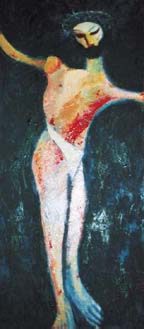 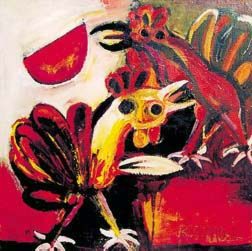  In 1957, he began studying
art at the Azimzade School of Arts in Baku. By this time, he
was already creating his own style of art, disregarding the instruction
to follow the Soviet school of Social Realism. On more than one
occasion, he was kicked out of school. Only because of some progressively
minded professors was he able to graduate in 1964. In 1957, he began studying
art at the Azimzade School of Arts in Baku. By this time, he
was already creating his own style of art, disregarding the instruction
to follow the Soviet school of Social Realism. On more than one
occasion, he was kicked out of school. Only because of some progressively
minded professors was he able to graduate in 1964.
Right: Kamal Ahmad, "Crucifixion
of Christ", 3' x 6', 1990s.
Kamal's name is often associated with Buzovna and the community
of artists who lived in that sea coast village on the Absheron
peninsula not far from Baku. Kamal lived in Buzovna until 1967.
He and Javad Mirjavad were both known for their bold, imaginative
styles and their fusion of traditional miniature painting with
elements of European progressive art. As a result, Kamal is considered
to be one of the founders of the "Absheron School of Arts."
Symbols of Light
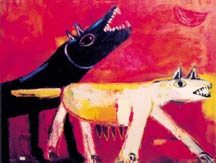  Kamal's paintings are
full of symbols, often painted on dark, black backgrounds. Many
symbols relate to concepts of light pitted against that darkness.
Invariably, there is his signature moon hanging low in the sky.
The moon appears bright red, yellow, white or even pink or blue
and seems to shed a mysterious light over the entire canvas.
Usually, it is crescent in shape (just like the Turkic symbol
on the Republic's new flag), but occasionally it appears almost
as a "half moon". Kamal's paintings are
full of symbols, often painted on dark, black backgrounds. Many
symbols relate to concepts of light pitted against that darkness.
Invariably, there is his signature moon hanging low in the sky.
The moon appears bright red, yellow, white or even pink or blue
and seems to shed a mysterious light over the entire canvas.
Usually, it is crescent in shape (just like the Turkic symbol
on the Republic's new flag), but occasionally it appears almost
as a "half moon".
Kamal Ahmad, "Dogs", 100 x 80 cm, oil on canvas,
1991.
Some say these moons symbolize "the incarnation of beauty
and poetry". In one of his paintings from the 1970s, he
even depicts the burial of the moon. The painting shows women
carrying a coffin, which cradles the moon. Kamal's wife Elmira
says that he was trying to express his anxiety and distress about
the demise of national poetry that he sensed was occurring. Kamal
was talented in his ability to recite poetry. In his youth, he
used to spend a great deal of time during his university years
in the library learning on his own, reading voraciously, not
only about the arts but about literature as well.
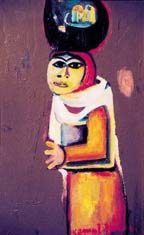 Another
important symbol related to this theme of light and darkness
is the lamp, burning with a yellow or white-hot flame. As a carrier
of light, the lamp represents hope in overcoming the darkness
and gloom that fill much of the rest of the space on his canvases.
Since the lamp illuminates only those things that are important
to the artist, it often creates a haunting sadness. Elmira says
that Kamal always felt some sort of a dark shadow hovering over
him because of all the obstacles in his path. Many of them were
artificially created by officials who did not like his opinionated
works. Another
important symbol related to this theme of light and darkness
is the lamp, burning with a yellow or white-hot flame. As a carrier
of light, the lamp represents hope in overcoming the darkness
and gloom that fill much of the rest of the space on his canvases.
Since the lamp illuminates only those things that are important
to the artist, it often creates a haunting sadness. Elmira says
that Kamal always felt some sort of a dark shadow hovering over
him because of all the obstacles in his path. Many of them were
artificially created by officials who did not like his opinionated
works.
It was for this reason that Kamal left the city and went to live
in the small village called Goradil near Fatmayi on the Absheron
Peninsula. He lived there for several years. The families there
helped him immensely every day taking turns and bringing him
food. They called him "our artist". It's likely that
many of them didn't even know his name. In essence, it was the
generosity of these villagers that kept him alive, not the government.
Kamal has a series of paintings dedicated to this village.
Kamal Ahmad, "Walking Woman-Refugee from Karabakh",
50 x 80 cm, oil on plywood, 1984.
Social Conscience
Many
of Kamal's works were dedicated to the problems that affected
Azerbaijanis in the 1980s and 1990s. In a painting entitled "Walking
Woman" (1984), he sympathizes with a refugee woman who is
fleeing from her home. On top of her head is a heavy bundle that
shows a tiny picture of her home. Kamal was especially sensitive
to the refugee issue since he himself had grown up in the region
that became occupied by Armenians. He also addressed the Black
January incident of January 19-20, 1990, when Soviet troops attacked
civilians in Baku's streets in their attempt to squelch the independence
movement. The "Massacre of Khojali" (February 1992)
refers to the town where hundreds of civilians, including women
and children, were murdered overnight as the Armenians began
their siege of Karabakh. Kamal had anticipated many of these
problems and, following the tradition of other poets and artists
during the Soviet period, gave them names that identified geographical
locations outside the Soviet Union, such as "Palestine Tragedy"
and "Chile" because of censorship.
Kamal Ahmad, "Goradil, Path to Heaven", his last
painting, oil, 1994
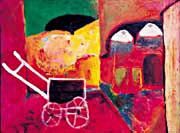  Kamal's subjects include
strange, fantastic birds, dogs, donkeys and other animals. He
also has a series of self-portraits. In the end, they seemed
much more optimistic and even included new colors including a
verdant green. In 1987, Kamal's first personal exhibition opened
in Baku. He was 47 years old at the time. A milestone in his
life, it signified the closure of what is known as his "Black
Period". In the years that followed just as the Soviet Union
itself was beginning to dissolve, he began to be acknowledged
for his works. In 1988, he won a prize for his work "Absheron
Women" in an all-Union Exhibition in Moscow. In 1989, he
won first prize for his painting "Initiation to Salvador
Dali" at the First Biennial of the Caspian Sea Republics
(Azerbaijan, Kazakhstan, Russia and Turkmenistan). In 1989, six
of his works were exhibited in Italy. During the Noruz holidays
of 1993, his series the "Artist's Family" went on exhibition
in Baku. Kamal's subjects include
strange, fantastic birds, dogs, donkeys and other animals. He
also has a series of self-portraits. In the end, they seemed
much more optimistic and even included new colors including a
verdant green. In 1987, Kamal's first personal exhibition opened
in Baku. He was 47 years old at the time. A milestone in his
life, it signified the closure of what is known as his "Black
Period". In the years that followed just as the Soviet Union
itself was beginning to dissolve, he began to be acknowledged
for his works. In 1988, he won a prize for his work "Absheron
Women" in an all-Union Exhibition in Moscow. In 1989, he
won first prize for his painting "Initiation to Salvador
Dali" at the First Biennial of the Caspian Sea Republics
(Azerbaijan, Kazakhstan, Russia and Turkmenistan). In 1989, six
of his works were exhibited in Italy. During the Noruz holidays
of 1993, his series the "Artist's Family" went on exhibition
in Baku.
Kamal's marriage
to a fellow artist, Zemfira Aliyeva, ended in divorce. Later
he married his second wife, Elmira. The couple had one daughter.
Elmira remembers Kamal as a person who had a very contradictory
nature but was very kind and straightforward and could forgive
every fault. He was critical of people, but deep inside he did
not wish harm or injury to anyone. First and foremost, he was
devoted to his art and expected everyone around him to make allowances
for that. She said, "He would have sacrificed his life for
us but not his art." Kamal met an untimely death in 1994
brought on, primarily, by self-neglect and abuse, sadness and
disappointment in life. His worth as an artist is just beginning
to be realized.
Farhad Khalilov and Elmira Ahmadova (Kamal's wife) both contributed
to this article. Elmira may be reached at Tel: (99-412) 71-98-54.
From Azerbaijan
International
(7.2) Summer1999.
© Azerbaijan International 1999. All rights reserved.
Back to Index
AI 7.2 (Summer 99)
AI Home
| Magazine
Choice | Topics
| Store
| Contact
us
|





 Another
important symbol related to this theme of light and darkness
is the lamp, burning with a yellow or white-hot flame. As a carrier
of light, the lamp represents hope in overcoming the darkness
and gloom that fill much of the rest of the space on his canvases.
Since the lamp illuminates only those things that are important
to the artist, it often creates a haunting sadness. Elmira says
that Kamal always felt some sort of a dark shadow hovering over
him because of all the obstacles in his path. Many of them were
artificially created by officials who did not like his opinionated
works.
Another
important symbol related to this theme of light and darkness
is the lamp, burning with a yellow or white-hot flame. As a carrier
of light, the lamp represents hope in overcoming the darkness
and gloom that fill much of the rest of the space on his canvases.
Since the lamp illuminates only those things that are important
to the artist, it often creates a haunting sadness. Elmira says
that Kamal always felt some sort of a dark shadow hovering over
him because of all the obstacles in his path. Many of them were
artificially created by officials who did not like his opinionated
works.